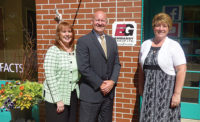Luxury Products Group, a vertical of the IMARK Plumbing buying group, recently held its annual expo in San Diego, California. There, Supply House Times sat down with members of the LPG Advisory Council in San Diego for an exclusive interview that touched on a variety of hot-button topics germane to LPG members’ businesses.
The interview panel included: Jeremy Smith (Central Arizona Supply); Don Smith (Central Arizona Supply); Pat McCarthy (Artistic Hardware); Jennifer Lopez (ProSource); Gary Cedrone (Republic Plumbing Supply); Christy Ellis (Sandpiper Supply); Kevin Castelo (Ultimate Design Center); and Leah Suffian (Immerse by Atlas).
LPG now has 361 members (a 47% increase from 2017 when Executive Director Jeff MacDowell started with the group) and 440 showroom locations. In 2019, the group enjoyed a 14% year-over-year sales increase in terms of purchases within the group and a 29% improvement in members working with new group vendors.
How has the main objective of LPG changed in recent times?
Jeremy Smith: “It definitely is broader than it originally was. We are appealing to a wide variety of showrooms in different stages of development. When we started, it was more focused on the wholesale type of showroom and how we can improve those. Now, it’s definitely more multiple types of showrooms where we’re all learning from each other.”
Just prior to this interview, LPG members packed a large conference room at the San Diego Marriott Marquis and Marina to discuss best practices with each other. “We had a new member who has showrooms in Utah,” McCarthy explained. “They were asking everybody at our table what does your showroom look like and what have you done to make your showroom special and different than others in your area? They were kind of starting from scratch. It was a grassroots conversation. This is the right direction here with LPG where we are helping some of these wholesalers who have showrooms bring their showroom up to the level of LPG.”
Cedrone, another veteran of the group, had a similar situation at his best practices table. “They were just getting started,” he said. “He talked about his showroom and what lines he’s focused on. I’m thinking, ‘My gosh, this guy knows his stuff and he had really just started.’ It’s amazing to see that kind of development in this group. In LPG, there is a place for all those people from those who have multiple showrooms to the single places only focused on luxury. It’s a little, big tent to me. We have a nice mix.”
Suffian, whose Immerse showroom was the 2019 Supply House Times showroom of the year winner, credits MacDowell for the group’s continued evolution.
“Jeff has brought in different tools,” she said. “He’s brought in marketing tools and he’s brought in different vendor-member relationships. It’s more of a partnership between vendors and members. There’s transparency. Nobody’s trying to hide anything in the vendor-member relationship. We’re all in this together.”
How are market conditions in your area?
Cedrone painted a competitive atmosphere in the Northeast where Massachusetts-based Republic is located. “What we have had to do is adjust certain cell matrices within our system so we’re not losing business,” he said. “We still maintain an edge on some of the lines we have exclusivity on, whether through the buying group or it being a territorial thing. We push our showroom personnel to stay within this group as much as possible. The only downside is if there are builders, contractors and designers who specify certain lines, sometimes you waiver a little and stay with them. You don’t want to lose that business trying to dictate something. We’re still maintaining that margin.”
Castelo, whose showroom was just named the 2019 LPG showroom of the year, noted the Denver/Colorado market has seen no softening. “There are rumblings with the builders that their models are not penciling out the way they used to because land and labor have gotten more expensive,” he said. “Even though they have told us this will lead to a slowdown, we haven’t observed it yet. Our biggest challenge is with hiring. It’s very hard to find qualified people and people who will stay.”
Ellis noted current market trends in the Savanah, Georgia area favor the luxury showroom. “Builders and designers are realizing the value of us because by using us and our knowledge, and having us guide the homeowner through the process, and bring everything in and check for quality before delivering it all at once when he or she needs it vs. drop-shipping from Amazon, that is really more valuable for them. They are guiding people toward us so we can help them save time, which in essence helps them save a lot more money.”
What concerns you in the industry right now?
Don Smith immediately brought up the online conundrum. “With some of our vendors we can find products being sold for less than our cost,” he said. “We do our best to take care of our customers, but also make enough profit for us as a company to be profitable.”
Cedrone turned the conversation toward millennial customers. “How do you attack and gain the millennial market because it’s a market. I said market,” he emphasized. “It’s a concern going forward because I live in an upscale apartment complex and there are millennials all over the place and Amazon Prime trucks every day, multiple times a day. As a brick-and-mortar store, we have to attack that demographic.”
McCarthy noted several instances where younger customers ordered products online and then came into his showroom with problems. “They see the value of coming into a showroom such as ours or any of yours where it’s not as simple as punching a button and having it show up on the doorstep tomorrow and working properly,” he explained. “We have to get that message across.”
Lopez circled back to the hiring quandary that was broached earlier in the interview. “How do I find talented people and how do I have the time to train these talented people?” she asked. “Generations prior, they found a job like this, they loved it, they sank their teeth into it and it was their career. Now, it’s a bit more scattershot. How do you find passionate people? It’s difficult. I will say this group is really helping address those questions and challenges.”
How important are showrooms in today’s supply chain?
Jeremy Smith brought up the specification guides Central Arizona produces to answer the question. “They see all of that in one place and they are amazed,” he said. “That’s part of our service and part of our process when a customer is making a selection. They are able to take this mini showroom of things they picked out and take it to their tile place or their countertop place compared to buying all that on the internet from multiple places and there is nobody there to package it together for them. If we continue to show the value to these builders, designers and plumbers, we still will have a place, and it will make the showroom just as important, if not more so than it ever was.”
McCarthy took Jeremy Smith’s story a step further. “A vendor made a beautiful piece that listed for maybe $1,100. A customer ordered a piece from an online retailer for $600 and said it was the exact piece and it came with a countertop,” he said. “She showed a picture to me and it looked like it. I ordered one and I had it sitting next to the vendor’s piece for about a year, and it was night-and-day different. I ended up selling it a year later to get it out of my showroom because it did what I needed it to do. You can’t tell by looking at a screen that’s it not high quality, not until it shows up on your doorstep. It’s not always about cost. You have to look at quality. That’s the ongoing battle.”
What’s the next big thing?
Several on the panel immediately pointed to category diversification. “In our marketplace it’s been a little bit more difficult to only work plumbing,” Don Smith said. “That’s why we have expanded some on the lighting side and now the appliance side because a lot of national and/or regional players are there. Customers don’t have to go to two different places. Expanding into these other verticals will be a positive for our company.”
Lopez added: “People don’t have a lot of time. They prefer to go in and shop and be taken care of and get it done in one swoop. Builders like the fact they don’t have to give them 10 vendor lists. That’s us giving them that luxury, making them feel important and then come in and take care of them. That’s what we are here for.”
Jeremy Smith concluded: “We are there giving them the luxury of time.”









